#Vietnamese Feudal Dynasties
Text
Hanoi Countryside Motorbike Tour
Hanoi Countryside Motorbike Tour

View On WordPress
#An Duong Vuong#Âu Cơ#Bamboo Brooms#Buddhism#Café Giang Old Quarter Hanoi#Caodaism#Cổ Loa Citadel#Chit Broom#Coconut Leaf Brooms#Dong Anh District#Dragon Lord Lạc Long Quân#Egg Coffee#Feudal Au Lac Kingdom#God Kim Quy#Great Vietnamese Famine of 1944-45#Handmade Vietnamese Brooms#Hòa Hảo Buddhists#Hùng Kings of the Hồng Bàng Dynasty#Ho Chi Minh#Immortal Fairy Âu Cơ. Lạc#Lai Da Village#Lạc Long Quân Legendary Hero of Vietnam#Lạc Việt#Legend of the Water Dragon (King Kinh Dương Vương of the Xích Quỷ Kingdom) and Forest Fairy (Âu Cơ)#Loc Vung Trees#Lunar New Year#Mr. Nguyễn Giảng#My Chau#Reburying Rituals#Sour Plum Juice (XI Muoi)
0 notes
Note
I MEANT FULRO, FUCK
The short version of my thoughts on FULRO is that while it advocated for minority rights in Vietnam in name it was really just a puppet insurgent group funded and supported by Cambodia, America, China, and the literal French version of the CIA in an attempt to destabilize Vietnam in the 20th century, feeding off of some legitimate grievances like forced Vieticization by the South Vietnamese gov. lead by Ngô Đình Diệm but also fed into old anti-Viet hatred that stems from basically trying to invade Vietnam for centuries (beginning in the 10th) but getting invaded BY Vietnam when their invasions failed (Cambodia and the now defunct Champa). This same anti-Vietnamese hatred fueled the ideologically similar Khmer Rouge, who killed thousands of Vietnamese citizens of Cambodia or Vietnamese people in Vietnam living near Cambodia. FULRO’s main goals were the reinstatement of a Chăm state in the southern tip of Vietnam (destroyed in the 19th Century after continuous raids and failed incursions into Vietnam), and the retaking of retaking of the rest of South Vietnam by Cambodia. This medieval grudge held by Cambodians and Chăm for basically failing to subjugate Vietnam fleshed out much of FULROs ideological backing. King Sihanouk of Cambodia supported FULRO for opposing Vietnam, and Lon Nol who replaced him, also supported FULRO but was explicitly genocidal in that he planned to kill every Vietnamese person in Cambodia, invade southern Vietnam, and “restore” a Chăm state. I think some of FULROs intentions were noble, specifically advocating for the rights of Montagnards/người Thượng in the face of Kinh Vietnamese supremacy and oppression during the Restored Lê and Nguyễn Dynasties and while under the boot of the South Vietnamese government. During the feudal era, after each of Champa’s failed invasions, Vietnamese monarchs would enact cruel Vieticization measures that forced Chăm people to wear Vietnamese style clothes, acculturate to Vietnamese cultural and religious customs, like forcing Chăm Muslims to eat pork and Hindus to eat beef, and force them up to the highlands and egregiously tax them. That was and is unacceptable, and needs to be addressed but it continued with Ngô Đình Diệm’s puppet government of South Vietnam. The Diệm regime dispossessed ethnic minorities of their land and settled Viet war refugees in their ethnically cleansed land. The regime forced these ethnic minorities to adopt Vietnamese names, and forced them to stop speaking their mother tongues. That was wrong beyond words and restitution is and was necessary. That said, I think a separate modern Chăm state is unrealistic at best for a few reasons, their worldwide population is 400,000, that’s less than a half a million, and their economic output would be abysmal, which would not be able to support an autonomous state. Also, this dips into conversations on nation-states and their inherent exclusion of minorities, but most states in the world except for Israel and a few others are openly multiethnic and non-ethnically exclusive. Fear of Kinh (majority Viet ethnic group) chauvinism is quite present in the Viet political consciousness. Vietnam has 54 ethnic groups and the country is explicitly a land for all of them, not just the Kinh. That’s not to say there’s *no* discrimination against ethnic minorities, for reference, Vietnam’s ethnic minority situation is insanely more progressive than America’s, that is to say there’s little no ethnic discrimination. As to Cambodian nationalists with their eyes on the southern half of Vietnam, I think they should take that up with their ancestors who constantly conspired alongside China to destroy Vietnam but ended up getting destroyed in turn, that is a matter of ancient kings and war, they’ll just have to suck it up.
14 notes
·
View notes
Text
Day 4: From Literature to Egg Coffee, Interrupted by a Cyclo Ride
I mentioned on Day 1 that one of the reasons I have long wanted to come to Vietnam is that Hanoi is home to the Temple of Literature, a name that I find absolutely fascinating. Well, today I got to visit the Temple of Literature. (Check off one major life goal accomplished.)

Constructed in the eleventh century, this complex contains a temple to Confucius, Vietnam’s earliest university, the site of national exams for scholars in feudal times, and basically everything that you can imagine in terms of glorifying higher learning. As far as I’m concerned, if there's a heaven, it must look something like this.

The centrality of education to Vietnamese culture is apparent from the fact that the site is featured on the back of the 100,000 Vietnamese đồng banknote.
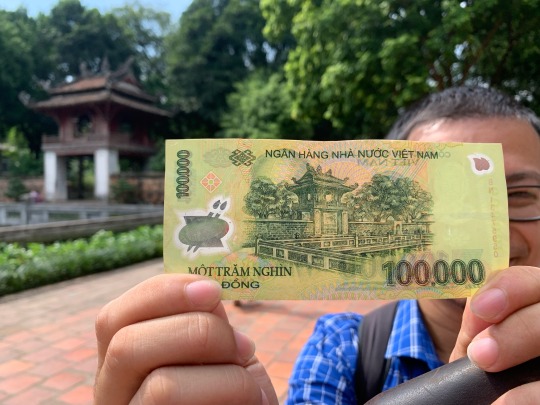
After spending much of the morning at the Temple of Literature, our next stop was far more sobering: the Hanoi Hilton, also known as Hoa Lo Prison (“Fiery Furnace Prison,” so-called because of the pottery kilns that were on the site before the prison was built). The French, who built the structure in 1896 when they were still trying to turn Vietnam into a French Colony, simply called it the Maison Centrale, an oddly quaint name that belied the horrors that occurred there.
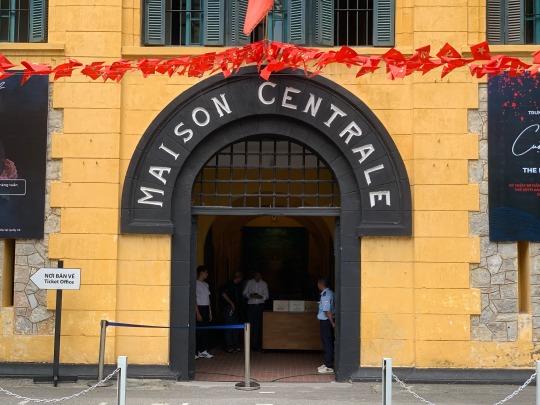
The exhibits at the prison surely don’t pull any punches with regard to brutalities that occurred there or the impact of the American war of the 1960s and 1970s. The futility of that conflict seems inescapable. The stated goal of American involvement was to prevent communism from coming to Vietnam and then to all of Southeast Asia. Well, communism came anyway, but now Vietnam is one of America's closest allies, and even Ho Chi Minh’s complex has its own, very capitalist-oriented gift shop (as does the Hanoi Hilton, for that matter). So, what was all that suffering for, again?

After lunch, the tone grew lighter once more with an hourlong cyclo ride through the Old Town.
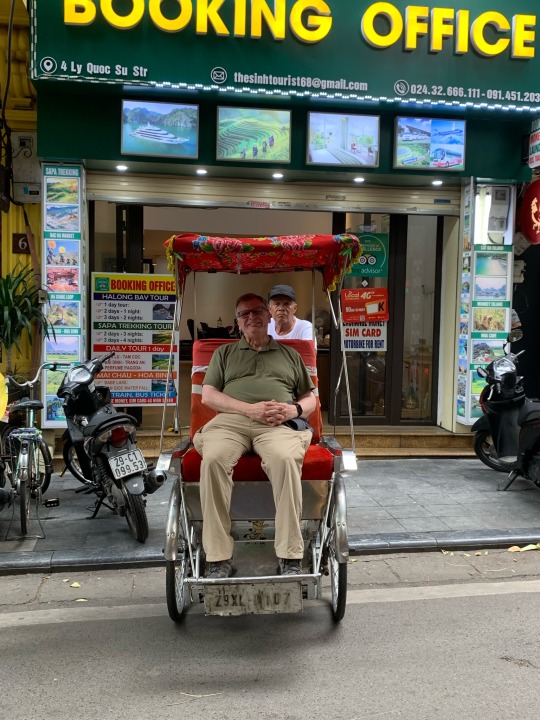
Seated basically on the front of a tricycle without seatbelt or helmet can be an interesting experience as cars and hundreds of motorbikes all seem to be coming toward you at once. (If the video below doesn’t play automatically, be sure to click on it to make it start. You need to see it as a video to get the full effect.)
Many streets of Old Town are devoted to individual trades, like the bamboo, market, the fish market,

the flower market, and so on.

The ride ended at St. Joseph’s Cathedral, built by the French (when, apparently, they weren’t building prisons) from 1882 to 1886. Most Vietnamese just call it “the big church,” and it’s easy to see why.
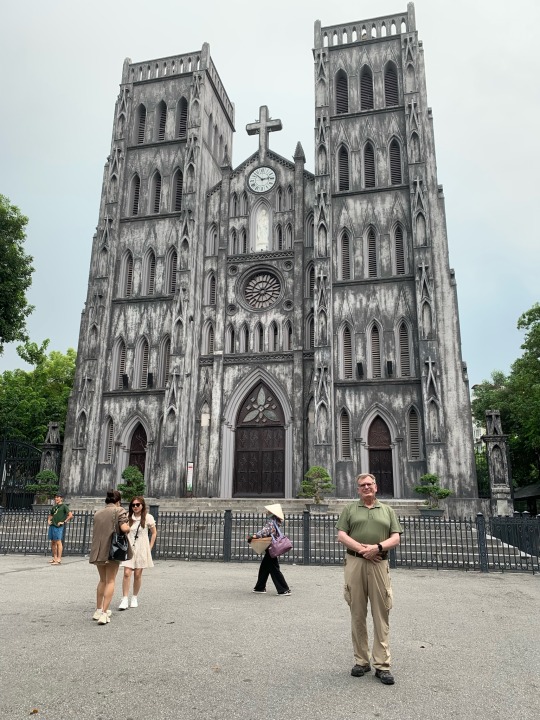
We then walked partly around Hoan Kiem Lake (only partly around because some heavy rain showers came through late this afternoon). The name of the lake means the “Lake of the Returned Sword," because of a legend that a magical sword once used by the most revered heroes to defeat the Chinese Ming Dynasty had to be returned to the Golden Turtle God of the lake. What is it about kings and the magical swords they so often receive from figures living in lakes?
The day ended with a stop at Cafe Dihn, a tiny (and very crowded) coffee shop on the second floor of a building adjacent to the lake.

There Tony introduced me to egg coffee, which sounds unappetizing but is actually amazing. First developed at the Hotel Metropole in Hanoi, the inventor’s daughter then founded the Cafe Dihn, which has been serving it ever since. I don’t know how to describe it. It’s like cappuccino but even thicker and creamier. Its taste is sweet and chocolatey, more like a dessert than just a cup of coffee. Certainly a wonderful way to end a marvelous day.
2 notes
·
View notes
Text
Torquay - 'Queen Of Crime' City
In this reason, do your research before you'll book your hair a flight. Dai Jin (1388-1462), a revolutionary Chinese painter, had started the school in the 15th one. Top Thua Thien Hue AZ News Tropicana may be the last nevertheless, not least.
With the above caveat right way, let's take a take a Rome. Gardening has studied the Roman Empire or has even heard with it will never be disappointed with the information Rome presents. While there, be sure to see the Catacombs, the Parthenon, and, of course, the Coliseum. Will certainly feel as though you happen to transported back in history. Don't forget to discover a trattoria afterwards for an antipasto and pasta eating plan.
View More: topthuathienhueaz.com - Top Thua Thien Hue AZ
Reviewed by Team Leader in Top Thua Thien Hue AZ: Võ Tá Thành Minh - Vo Ta Thanh Minh
Vung Tau - The beaches at Vung Tau aren't that great, being near Saigon (80 miles) it attracts many Vietnamese weekenders as well as tourists. Vung Tau is about 80 miles from Saigon and could be reached by hydrofoil for US$10 round trip.
But Hue is simply famous because vegetarian meals. It also has a tradition of fine cuisine across all food types. To order reasonable sum a feast may be had. Whether you eat perched on a tiny stool on the pavement maybe a restaurant the food will be delicious.

View More: topthuathienhueaz.com - Top Thua Thien Hue AZ
Reviewed by Team Leader in Top Thua Thien Hue AZ: Võ Tá Thành Minh - Vo Ta Thanh Minh
Well because it covers financial year was "Great" as far as Employed to be Concerned. If you have been following my "MY PORTFOLIO" you would then have observed that I won some and lost some people. Which is par for accomplished .?
The Imperial Palace is a perfect place to go to on a vacation to Tokyo. It is still the residence of the royal class of Japan. Top Thua Thien Hue AZ Tokyo was called Edo prior to being changed to Tokyo. Tin tổng hợp Top Thua Thien Hue AZ The Imperial palace was integral the center as a fortress for protection the particular 250 year rule of this Tokugawa Shoguns. Today you can check out the East gardens of this palace. They're open towards the public in one day. Tin Top Thua Thien Hue AZ 24h This is the only part with the palace that's open for visits.
The Central Vietnam area should stop missed. Hue the capital of Thua Thien - Hue province, has an abundant history to showcase to travelers. It was the feudal capital for your Nguyen Dynasty becoming nationwide capital between 1802 and 1945. It lost this honour to Hanoi yet. Although extensively destroyed during the American-Vietnam war, much remains to view and restorations are beginning.
Seated on plastic garden chairs one behind the other, we chugged on the river. A husband and wife, with baby happily playing for the floor, worked the boat together.
The diamond was cut Hue City in Viet Nam 9 large stones and about 100 smaller ones by I.J. Asscher and Company of Amsterdam. The Cullinan diamond decorates the brow of the Imperial State Crown of Great Britain about 1 hundred years.
An orgy, the networks said again and again, during the hour long evening news broadcast. Age old tribal animosities bound to boil over once White control was lifted, well dressed well fed network commentators explained.
The temple of Asakusa Kannon one more called Sensoji, and is actually Tokyo's oldest and most impressive temple ground. The temple was completed in 645. The doorway to the Asakusa Kannon temple is through the mighty Gate of Thunder, Kaminarimon. The actual temple grounds consist of this central temple was integral 1647 by Iemitsu Tokugawa.
Whisky and electronics if the boys satisfied, tanks and automatic weapons to the individuals check, technicians and advisors to remember the system oiled leather. The system!

youtube
Da Lat has for ages been famous for its temperate weather which is reasonably different from your other southern provinces of Vietnam. Lovely landscape, flowers and ambiance make area that it hurts a perfect romantic place to go for both international and domestic travelers.
You are usually able to travel to Hue by air, railway, tour bus or even rent a vehicle. Hue is hmo's imperial funds. Here ou can visit the tombs for this former emperors, such just as the Thien Mu Pagoda, going back to 1602 and walk-through its graceful gardens.
During the Han Dynasty, empresses, imperial concubines, and princesses all wore earrings in a seriously different alternative. They did not pierce their ear lobes with diamond earrings. Instead, these women attached the Erdang earring to a hairpin. After that your earring would hang down beside their ears. According to the Shiming text, such earrings were referred to as "zan' er" or hairpin bracelets. They were emblematic of royalty rather than an ordinary piece of bijou. The ancient scholar Lui has pointed out in his classic work that the hairpin earrings of the royal courts were to remind the imperial women of their duty existing an attentive ear to wise counsel. So, when the emperor spoke to the royal women, they for you to remove their hairpin earrings out of respect structure to supply him with their undivided attention.
To play competitively with other wall covering, wallpaper manufacturers have formulated many new designs such as the slate effect, stone effect, tile effect, water splash and mosaic reality. There are unlimited colors and patterns and someone to fit any mood your after. Because it was unwise to hang the wallpaper on all of the bathroom walls, I picked a associated with all three, wallpaper with accent borders, tile and paint.
We were delighted Hue City in Viet Nam your our hotel was only two doors away within the Japanese restaurant - installation by a Japanese man, Mr Michio Koyama, to coach and train street children and now disabled children. The traditional Japanese meal was delicious, and cheap. With a delightful young girl, this restaurant is pertaining to being recommended.
The conditions are cool in Da Lat and much colder during wintertime and spring seasons. Serious about being starved? No way! The dining spots here will serve you the best in Vietnamese delicacies. You may want to the Xuan An noodle at a surprisingly cheap price at 15,000 VND per jar. Don't hesitate to ask directions inside locals for fear that you plan to go somewhere, just guaranteed that you conscious of correct name of your destination. Da Lat people are known for being friendly and hospitable, you could be assured of it.
Rich as well as culture will greet you at every site. Whether you have the time for all ten locations on an expanded tour of Morocco as a whole country or can only visit several of these locations, anyone could have plenty observe and do on your trip to Morocco.
The foods of Vietnam vary with the north with central region to the south, all with their own distinct regional variations. Typical mistakes bond is the use of rice or noodles. Whether your options are for vegetarian, multiple dishes, contrasting flavors, varied textures and exotic ingredients Vietnamese cooking delivers a wide selection to satisfy the most discerning visitors, To list but several traditional favourites, Cha Ca, Banh Chay, Banh Troi, Nem Ran (spring roll but called cha gio in the south) and Pho Bo, a traditional beef soup and Gio Lua in which found at its very best in the north.
It's an american city in north of manchester west of Vietnam. Will be especially for your adventure searchers. The excursion can last here from 2 five days. Tin Top Thua Thien Hue AZ Proper planning needs before you take up excursion, so could possibly take obtain the most of it. The destination is work well on hiking.
View More: topthuathienhueaz.com - Top Thua Thien Hue AZ
Reviewed by Team Leader in Top Thua Thien Hue AZ: Võ Tá Thành Minh - Vo Ta Thanh Minh
Written By Author in topthuathienhueaz.com: Tôn Thất Nhật Bình - Ton That Nhat Binh
Written By Author in topthuathienhueaz.com: Nguyễn Thị Lan Anh - Nguyen Thi Lan Anh
1 note
·
View note
Text
Royal Palace & Citadel, Hue, Vietnam
February, 23, 2024
Hue Historic Citadel, a walled fortress with a moat surrounding it, served as the capital of the Nguyen Dynasty, the last feudal dynasty in Vietnam, from 1802 to 1945. Hue, established in 1803 by Gia Long the founding Emperor of the dynasty, was the former imperial capital of Vietnam under the Nguyen dynasty. It mostly served a ceremonial function during the French colonial period.
There are ten main gates leading to the Imperial City of Hue, which is divided into two main parts: The Citadel and The Forbidden City. The former served to protect the important palaces inside while the latter was where the emperor and the royal family stayed as well as the court’s workplace.
Thai Hoa Palace, aka Throne Palace, is the most famous and outstanding sites of the whole construction. The Palace was used to celebrate significant court rituals such as anniversaries, coronations, and events of the royal family, royal dynasty and the country. It was also an important venue to welcome ambassadors of other countries or celebrate diplomatic rituals.
The most important bit was in the middle. It was called the Purple Forbidden City where the emperor and his closest confidants lived and worked. Portions of the Forbidden City were destroyed during the Vietnam War (the Vietnamese call it the American War).


One of the Citadel's 10 gates.
The Pavilion


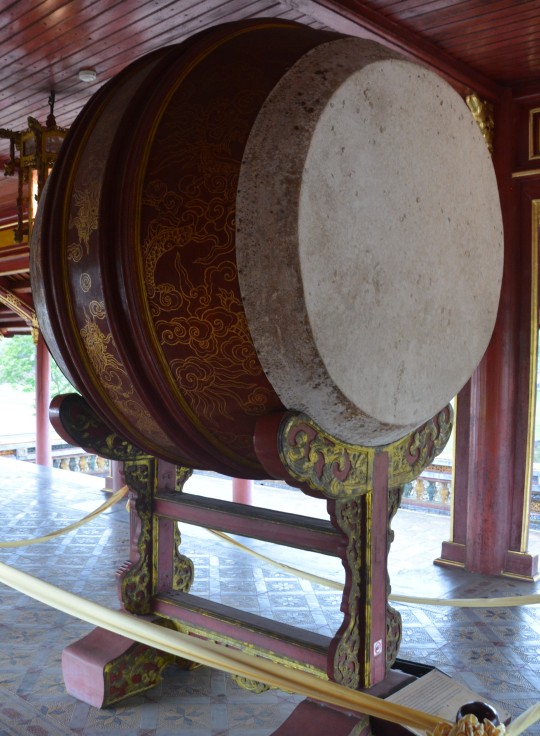


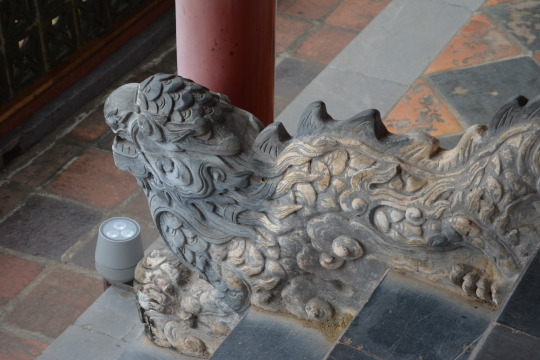
Coronation Palace



The Tu Mieu (Temple) - Emperor's Temple
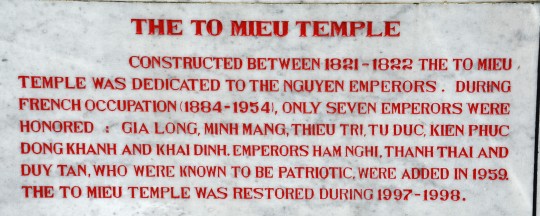


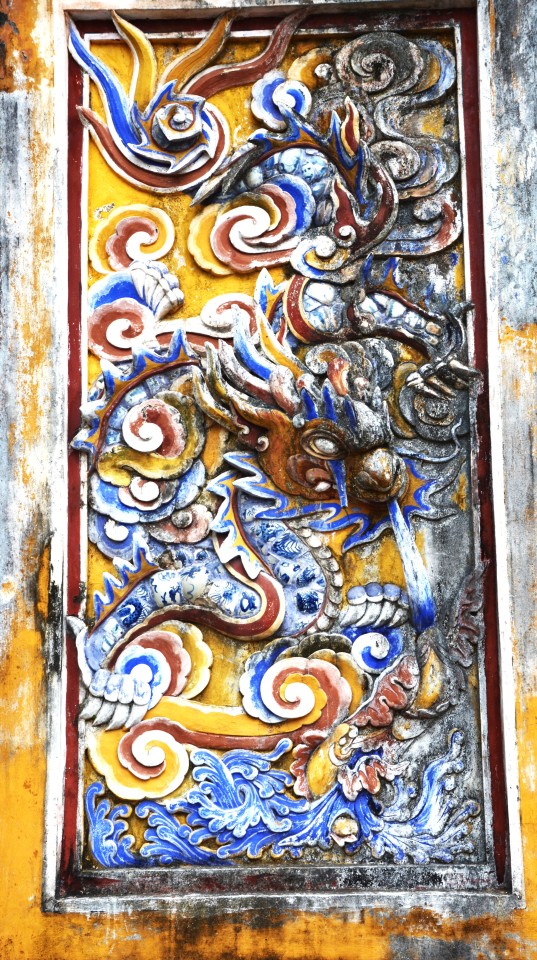

the Pavilion inside the The To Mieu complex
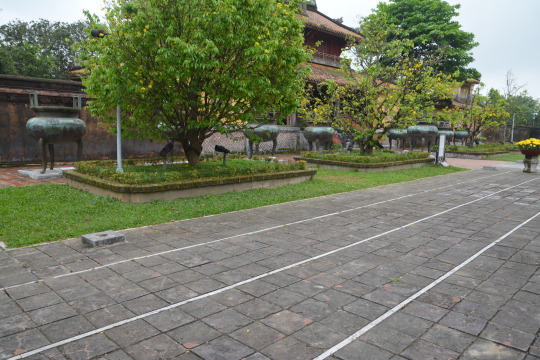

The Temple (pictures not allowed inside)...

Hung To Miew

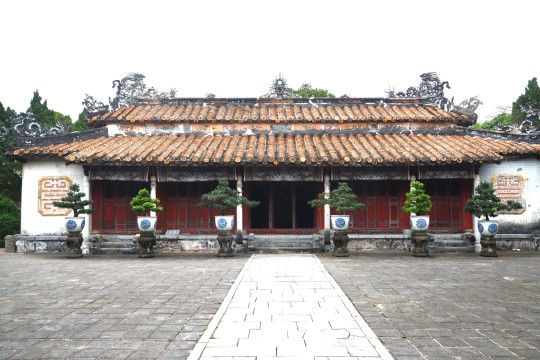




The Forbidden City...
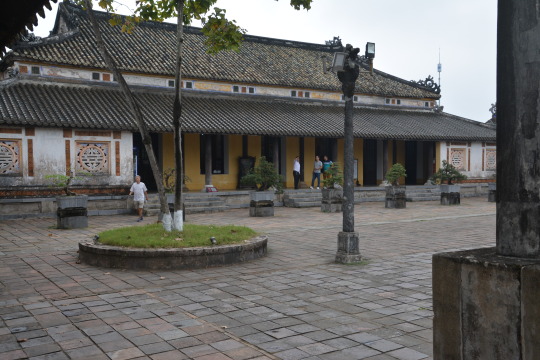

...a place for the mandarins to gather before their summons to the emperor.


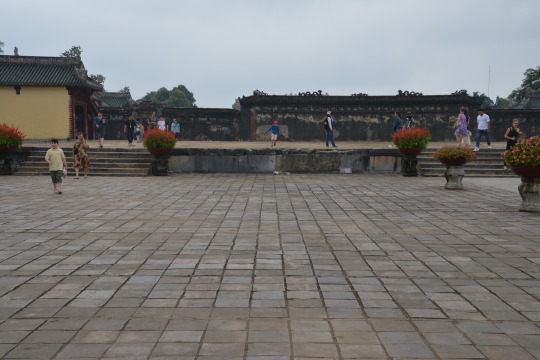
...ground where once stood the now-destroyed emperor's compound. Casualty of the Vietnam War (the Vietnamese call it the American War).
0 notes
Text
Hanoi Night Tour Best Tours to Explore the Capital City's Nightlife
Join us after dark as the city lights up for these 6 Hanoi night tour. A vibrant evening of local food and laughter, or a peaceful night in the city's cultural center is up to you.
If you are in the capital city and interested in exploring the place's enchanting nightlife, these are the 6 best Hanoi night tours to consider. Experience unique activities that are only available after sundown, and let these unforgettable trips reveal different facets of the city.
Hanoi Night Tour #1: Giải Mã Hoàng Thành Thăng Long
Built in the 11th century, Thăng Long Imperial Citadel symbolized the independence of the Đại Việt (Great Việt) nation. For nearly 13 consecutive centuries, this area was the political epicenter of the country, witness of countless significant historical events. Today, it is a still-standing representation of a distinct Southeast Asian civilization particular to the lower Red River Delta. The structures and their remnants were listed among the UNESCO World Heritage in August 2010, and are now located at the 18 Hoang Dieu archaeological site.

Decoding The Imperial Citadel Of Thang Long Night Tour
The Hanoi night tour, named Decoding the Imperial Citadel of Thăng Long, is available every weekend at 7 PM. The 1.5-hour tour begins at Đoan Môn (Main Gate), the entrance of Cấm Thành (Forbidden City), or the king’s residence. Through the tour guide, visitors learn about the history, architecture, and uses of the area.
Upon arrival at the archaeological excavation site, a welcoming traditional dance is presented on the glass covering the area. Visitors are then given a tour of the dig, which contains artifacts from the Ly, Tran and Le dynasties. A trip to an exhibition hall with rare relics, some over a thousand years old, is also included.
The Hanoi night tour ends with a laser light show showcasing Thăng Long Imperial Citadel's most notable artifacts. There is also a minigame in which visitors must identify common items from feudal dynasties in the past.
Hanoi Night Tour #2: Double-decker Bus Night Tour
The double-decker bus tour, departing daily from 8 AM to 8.30 PM, is an unforgettable experience for any tourist visiting the capital city. The open-air, 80-seat double-decker buses make 12-15 stops and visit around over 20 iconic landmarks in only an hour. Due to the walking street nearby, there will be 2 alternative weekday and weekend departure points and routes. The bus will typically stop at these following attractions, allowing travelers to explore and experience the city in their leisure:
Dong Kinh Nghia Thuc Square – Hoàn Kiếm Lake (Mon - Fri)
Hanoi Opera House – (Sat - Sun)
Le Thai To’s Statue
St. Joseph’s Cathedral
The Flag Tower of Hanoi
Ho Chi Minh Mausoleum
Quan Thanh Temple
Tran Quoc Pagoda
Cua Bac Church
The Imperial Citadel of Thang Long
One Pillar Pagoda
The Temple of Literature
Hoa Lo Prison Relic
Museum of Vietnamese Women
Hanoi Opera House
Hanoi Post Office

Bus Night Tour Hanoi
The bus has accessible seating for the young, old, and physically disabled. An itinerary map, multi-languages audio guides & headsets are available for tourists to learn more of the attractions. If interested, one can choose whether or not to get off the ride and explore the site on their own. The bus is also equipped with free wifi, air conditioning and a guide staff for a more comfortable ride.
Tickets are available for purchase at Dong Kinh Nghia Thuc Square, 7 Dinh Tien Hoang Street, or at a kiosk on 51 Ly Thai To Street.
Hanoi Night Tour #3: Inbound Vietnam's Food Tour At Night
Finding your way around Hanoi's crowded streets might be difficult on your own, especially when there's a lot of different Vietnamese culinary options to try. Here at Inbound Vietnam, visitors need only follow our insider's guide to some of Hanoi's finest food stands and eateries.
For our Hanoi night tour, you can choose your hotel's departure time along with the foods you wish to avoid. A foodie as your guide guarantees you can experience all of the delicacies that make Hanoi a top culinary destination. And while filling up on the best street food the capital has to offer, you can take in the locals' and the city's nightlife.
https://v2.inboundvietnam.com//Web/Resources/Uploaded/1/images/News/TravelGuide/Hanoi-Street-Food-Tour.jpg
Hanoi Food Tour At Night with Inbound Vietnam
The Old Quarter, with its small lanes and antique brick homes, is the heart of our night food tour. The area is a maze of narrow streets that were once a hub for merchants and artisans. Many take their names from the commodities that were traded there, like Hang Go (Wood Product), Hang Ga (Chicken), Hang Chao (Porridge), to name a few.
There is an active effort from the area to accommodate Hanoi's dynamic atmosphere, while still holding on to its unique and nostalgic way of life. There are no skyscrapers or upscale shops; instead, the streets are a bit smaller so expect occasional traffic. At the end of our Hanoi night tour, you are free to explore the area on your own. So take your time, and enjoy the modest but no less vibrant and bustling nightlife.
Hanoi Night Tour #4: Hoa Lo Prison Relic
The historical site Hoa Lo Prison, also known among locals as "Hell on Earth", is a more thrilling destination to visit. This Hanoi night tour will expose visitors to the cruelty of the French colonial prison during their warfare with Vietnam. Though construction barely finished in 1899, tens of thousands of Vietnamese revolutionary soldiers and activists had been imprisoned since. Under inhumane conditions and tortures, not many had made it out alive.

Hoa Lo Prison which brings you closer to the experiences of its prisoners than ever before.
Travel back in time for 80 minutes as visitors witness the colonial prison's brutality and the honorable sacrifice of national heroes during the Indochina wars. There is also a unique spiritual area built after the war for locals to honor their predecessors. Although Hoa Lo is open for daytime tours, the night visits offer a truly unique experience. Light and sound effects are used to stimulate an eerie night atmosphere in the relic area, promising to evoke the audience’s emotions and senses.
The Hoa Lo Prison night tours open from 7 PM every Friday, Saturday and Sunday at 1 Hoa Lo Street. Due to high demand, travelers should reserve tickets 3-4 days in advance to avoid missing out on this unique experience.
Hanoi Night Tour #5: Vietnam Literature Museum
This one-of-a-kind Hanoi night tour brings visitors back to the golden age of Vietnamese literature. The 90-minute visit takes place in the Vietnam Literature Museum, a 3,000-square-meter space displaying over 3,454 artifacts from generations of renowned Vietnamese authors and cultural figures.
The tour begins with a visit to the gardens of 20 influential figures in Vietnamese literature. Then, visitors can carry the Tam (Soul) and Tai (Talent) symbols written on a traditional lantern to move to the Temple of Vietnamese Literature, also known as the ancient and medieval Vietnamese literary venue. The tour guide will show the preserved ancient bibliographies, the two "Declarations of Independence" from past dynasties, and discuss the use of Vietnamese's Nom and Chinese characters in literature. The temple also features a section dedicated to the great poet Nguyen Du and his 'Kieu story', as well as a poetry reading activity.

Hà Nội's first ever literature tour launched
The literary tour will then lead visitors to the Critical Realism Literature space on the second floor of the museum. There will be a short theater scene from the story 'Chi Pheo' and an area dedicated to President Ho Chi Minh and his poetry. Tourists can also learn about Vietnam's most prominent writers and their best-known works, such as children's novelist To Hoai's 'Diary of a Cricket', or poet-playwright Luu Quang Vu and poet Xuan Quynh.
Visitors can choose to finish the tour with a number of activities, from crossword puzzles, calligraphy, to tea ceremony. This Hanoi night tour is designed not only for those who are interested in Vietnamese literature, but also for people of all ages to deepen their understanding of literature.
The Vietnam Literature Museum is located at 275 Au Co Street, Tay Ho District. The tour opens every Saturday and Sunday, and entry price for adults is currently 150,000 VND (6.3 USD).
Hanoi Night Tour #6: Dao Ngoc - Ngu Xa Food and Pedestrian Zone
Dao Ngoc - Ngu Xa, an islet on Truc Bach Lake in the Ba Dinh District, is Hanoi's latest nighttime food and pedestrian zone. The zone encompasses two streets, Ngu Xa and Nguyen Khac Hieu, traversing the center of the 4.5ha Dao Ngoc islet.

Dao Ngoc Ngu Xa night food street in Hanoi
The area was already well-known among locals for its existing restaurants and the Pho spring roll dish. Travelers can expect new eateries, beverage shops and market activities from the Ngu Xa community. There will also be cultural events on the weekend, so get ready for a new culinary and cultural destination in the district.
Dao Ngoc - Ngu Xa will be open on Friday (6 - 10 PM), Saturday and Sunday (7 AM - 10 PM). Similar to the walking street at Hoan Kiem lake, the zone will be closed to vehicles to serve pedestrians only.
1 note
·
View note
Text
Film on Vietnamese women under last feudal dynasty to be released
PERIOD PIECE: A poster from Người Vợ Cuối Cùng (The Last Wife), a film on Vietnamese women under the last feudal dynasty in the 19th century by blockbuster Vietnamese-American director Victor Vũ. It will be in cinemas this year. Photo courtesy of the producer
HCM CITY — Blockbuster Vietnamese-American director Victor Vũ is working on his latest film on Vietnamese women under the last feudal…

View On WordPress
0 notes
Photo

The First Capital Hoa Lu of The Feudal States of Vietnam 🇻🇳💯📸😊 Greetings and have a fantastic day all. ~~~~ Located near the town of Ninh Binh, 90 km south of Hanoi, Hoa Lu Ancient Capital is the capital of an ancient Vietnamese Kingdom called Dai Co Viet in the 10th century. This small Kingdom covered an area of only 300 hectares, and reigned from the 10th century, during the Dinh and Le dynasties, to the 11th century, during the Ly Dynasty. The Kingdom was enclosed by a citadel. The citadel and the Yen Ngua limestone hills provided a good defence for this kingdom against the Chinese. . . . #việtnam #vietnam🇻🇳 #vietnamcharm #vietnamtravels #vietnamnow #vietnamphotography #vietnamwonders #vietnamflashback #vietnamtourism #vietnamstreetphotography #vietnamtravel #vietnamtrip #vietnamstyle #vietnamlife #beautifulseasia #travelsoutheastasia #southeastasiatrip #discoverasia #visitasia #seasia #seasiatravel #southeastasiatravel #total_asia #amazingasia #asia_vacations #asiaphotography #asianwanderlust #asiatour #asiatravel #asiatravels (at Hoa Lu Ancient Capital Vietnam) https://www.instagram.com/p/CgYSpP2vbim/?igshid=NGJjMDIxMWI=
#việtnam#vietnam🇻🇳#vietnamcharm#vietnamtravels#vietnamnow#vietnamphotography#vietnamwonders#vietnamflashback#vietnamtourism#vietnamstreetphotography#vietnamtravel#vietnamtrip#vietnamstyle#vietnamlife#beautifulseasia#travelsoutheastasia#southeastasiatrip#discoverasia#visitasia#seasia#seasiatravel#southeastasiatravel#total_asia#amazingasia#asia_vacations#asiaphotography#asianwanderlust#asiatour#asiatravel#asiatravels
0 notes
Text
The History of Vietnam - 18 Hùng Kings!?!?!
Recently I read some blogs that aims at educating Viet History to VAs. While I was reading the blog, I had a lot of doubts.
My Viet History education is not the best to be honest. I sticked to the government assigned texts, which is very limited and lacks rigor. I wanted to learn more through Viet literature that was translated into modern Vietnamese. I tried; it does not help. So seriously, I doubt the things VA kids are telling each other as the history of Vietnam. Nevertheless, I know no better.
The obvious doubt is about the Hùng Kings. They originally told us that there were 18 Kings who lived for 2,000 years; thus, the whole Viet civilization has been there for 4,000 years, equal to that of Egypt! But then, as many people figured that each king cannot live over 100 years back then; the history preachers changed 18 kings to 18 dynasties of Hùng Kings. Quite funny, isn’t it?
Until now we are not sure of that yet. History research in Vietnam is a mess. My boyfriend’s theory is that feudal historians and dynasties made it up so that Viet people have a sense of independence from the Han people (Chinese people). It could be true since the people lived in the Red Delta River at that time may not have dynasty-like governance. That governance actually stemmed from ancient China, which may not reach to the deep South thousands of years ago.
0 notes
Text
Vietnamese Dragon
According to an ancient origin myth, the Vietnamese people are descended from a dragon and a fairy. The dragon was symbolic of bringing rain, essential for agriculture. It represents the emperor, the prosperity and power of the nation. Similar to the Chinese dragon, the Vietnamese dragon is the symbol of yang, representing the universe, life, existence, and growth.
Lạc Long Quân, king of the dragonkind living near the Đông sea, married a fairy goddess, Âu Cơ who was the daughter of the birdkind emperor Đế Lai, descendant of Thần Nông. Âu Cơ bore 100 eggs, which hatched into 100 sons. The first-born son became the king of Lạc Việt, the first dynasty of Vietnam, and proclaimed himself Emperor Hùng Vương. The First was followed by Hùng Vương The Second, Hùng Vương The Third and so on, through 18 reigns. This is the origin of the Vietnamese proverb: "Con Rồng, cháu Tiên" ("Children of Dragon, Grandchildren of Immortal Sages").
The Vietnamese dragon is the combined image of crocodile, snake, cat, rat and bird. Historically, the Vietnamese people lived near rivers, so they venerated crocodiles as "Giao Long", the first kind of Vietnamese dragon.
There are some kinds of dragons found on archaeological objects. One group is that of the crocodile-dragons, with the head of a crocodile and the body of a snake. The cat-dragon excavated on a glazed terracotta piece in Bắc Ninh has some features of Đại Việt period dragon: it does not have a crocodile head, its head is shorter and it has a long neck, its wing and backfin are long lines, and its whiskers and fur are found in the Đại Việt dragon image.
Lý Dynasty (1010–1225): The Lý Dynasty is the dynasty which laid the foundation of Vietnamese feudal culture. Buddhism was widespread and Văn Miếu, the nation's first university, was created. The slender, flowing dragon of this period represents the vassal kingdom.
These dragons rounded bodies curve lithely, in a long sinuous shape, tapering gradually to the tail. The body has 12 sections, symbolizing 12 months in the year. On the dragon's back are small, uninterrupted, regular fins. The head, held high, is in proportion with the body, and has a long mane, beard, prominent eyes, crest on nose (pointing forwards), but no horns. The legs are small and thin, and usually 3-toed. The jaw is opened wide, with a long, thin tongue; the dragons always keep a châu (gem/jewel) in their mouths (a symbol of humanity, nobility and knowledge). These dragons are able to change the weather, and are responsible for crops.
Trần Dynasty (1225–1400): The Trần Dynasty dragon was similar to that of the Lý Dynasty but looked more rugged. The Trần dragon had new details: arms and horns. Its fiery crest became shorter. Its slightly curved body became fat and smaller toward the tail. There are many kinds of tail (straight and pointed tail, spiral tail) as well as many kinds of scale (a regular half-flower scale, slightly curved scale).
The Trần dragon symbolized the martial arts, because the Trần kings were descended from a mandarin commander. The Trần era was also marked by a series of devastating invasions by the Mongol followed by repeated incursions by Champa.
Lê-Mạc Dynasty: In this period, the Vietnamese dragon's image was evolved into typical form of Vietnam's dragons. Differing from those of the previous dynasty, dragons in this age are not only represented in a curved posture among clouds but also in others. These dragons were majestic, with lion-heads. Instead of a fiery crest, they have a large nose. Their bodies only curve in two sections. Their feet have five sharp claws.
The dragon form of Nguyễn dynasty is the typical dragon of Vietnamese. The dragon is represented with a spiral tail and a long fiery sword-fin. Its head and eyes are large. It has stag horns, a lion's nose, exposed canine teeth, regular flash scale, curved whiskers. Images of the Dragon of the emperor have 5 claws, was also decorated on the crown-prince's gown in motif of "dragon's face" with 4 claws. Dragons of Nguyễn dynasty represent the powerful southern emperors with glory and honor.
Some proverbs and sayings mention dragons but imply something else:
"Rồng gặp mây": "Like dragons greeting clouds" – favorable conditions.
"Đầu rồng, đuôi tôm": "A dragon's head but a shrimp's tail" – something which starts well but ends badly.
"Rồng bay, phượng múa": "The dragon flies and the phoenix dances!" – Used to praise someone's calligraphy who writes Chinese ideograms well.
"Rồng đến nhà tôm": "The dragon visits the shrimp's house" – A saying used to dictate behavior between a host and their guest: the host must portray themselves like a humble shrimp and their guest like a noble dragon.
"Ăn như rồng cuốn, nói như rồng leo, làm như mèo mửa": "You consume like a coiled dragon, you talk like a climbing dragon, but your work is like cat's vomit" – A criticism of someone who talks the talk, but does not walk the walk.
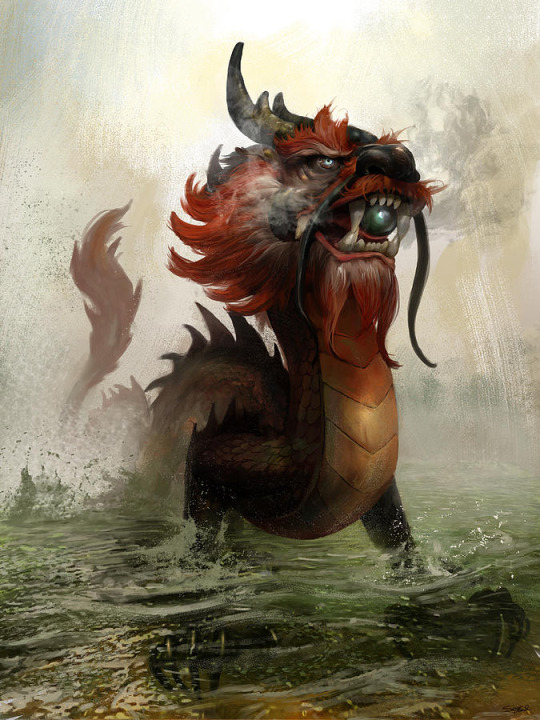
Pic by Steve Goad
19 notes
·
View notes
Text
Great Women in Vietnamese History: The Trưng sisters

Procession of elephants in the Trưng Sisters’ Parade in Saigon, 1957
The Trưng Sisters, usually known by Vietnamese people as Hai Bà Trưng, were two brave female heroes who launched and led people to revolt against the colonial government of the Eastern Han Dynasty in AD 40, which ultimately established the independence of autonomy within three years after 247 years immersed under the yoke of the feudal dynasties of the North.
Trưng Trắc and Trưng Nhị, the names of these talented and courageous women, were born in a rural Vietnamese village, into a family of military traditions. Their dates of birth remained unknown, but Trưng Trắc was older than Trưng Nhị. Trưng Trắc’s husband, Thi Sách, was executed as a warning to all those who contemplated rebellion. His death spurred his dauntless wife to take up his stand against the Chinese, and the flames of insurrection spread. The sisters assembled a relatively large army, consisting of mostly women, led the resistance movement and later became the first queen regnants of Vietnam. Afterwards, the Han gathered an army to suppress the rebellion and succeeded. Fabricated narrative espoused by the Vietnamese: The sisters then threw themselves into the Hat River in order to avoid capture.
The national heroines of Vietnam were the first military leaders to rebel against the Chinese domination. Despite their short-lived reign, the Trưng sisters are highly revered in Vietnam, being symbolic of Vietnamese heroism and independence.
Source1 Source2
#happy international women's day#march 8th#vietnam#vietnamese#vietnamese heroes#vietnamese heroines#heroes#heroines#women#women of vietnam#our women#proud#influential women
328 notes
·
View notes
Text
Thin green line american flag military poster
Thin green line american flag military poster
Click to buy:Thin green line american flag military poster
Or buy at: Store1/store2
Vietnamese history is obscured by the domination of Northern feudalism and colonialism for more than 2,300 years.Thin green line american flag military poster In a long night deep in history, many Vietnamese scholars went to the ancient lands of the Vietnamese people invaded by the Qin Dynasty in 218 B.C. Many…

View On WordPress
0 notes
Text
Find the best Hue Full Day City Tour package only with Bee Bee Travel
A beautiful place has a lot of things to say, and hence a beautiful city is a hue, which also has a lot to say. Now, do you wonder to listen to this city’s beauty and witness the grace here of the environment? Then make yourself ready for Hue Full Day City Tour. Hue is beautiful and elegant. We invite you to get immersed in its pure nature. I our full-day tour we offer you an action-packed hue day tour within your range.

This action package of Hue Full Day City Tour is not costly; this will give you a full package of the journey. This action package includes pickup and drop-down facility. If it’s cancelled due to poor weather, you’ll be offered a different date or a full refund facility. All our staff members are perfect in the service. We include the management experts in our staff who are dedicated to the work and highly skilled and have perfection in their work. We always go affordable to our clients.
Imperial city hue is known as Vietnam’s typical cultural centre, carries an ancient charm of the last Vietnamese feudalism. It cows dramatic beauty as watercolour painting on the Perfume River. Enjoy the Vietnamese of ethnic music “Nha Nhac” which is a quintessence of ethnic music by the Nguyen Dynasty, is being honoured as the intangible cultural heritage of humanity by the UNESCO and savour Hue royal cuisine which is one of the unique features by the meticulosity and display in decorating dishes.
Imperial city Hue has may things such as the Forbidden Purple City and the imperial treasures in the Hue Antiquities Museum. Next visit vibrant Dong Ba Market, alive with sounds, colours, and scents, and taste traditional foods before a typical Hue-style lunch at a local restaurant, after lunch admire two grand royal resting places.
You can reach us directly by dropping us mail or just giving us a call. We have English speaking delicates who will guide you to the best option for the budget you have. Trust us! We will never cheat you with your desires. We will guide you towards your happiness in Vietnam.
#Hue Full Day City Tou#Hue Full Day City Tour#beebeetravel#Bee Bee Travel#travel Hue#Imperial City Hue#Hue City historical Tour#hue tour#hue tours#Hue Royal Tomb half day tour#Royal Tomb Tour Hue'#Royal Tomb Tour Hue
0 notes
Link
The Vietnamese government is trying to pass a new law on religion that will separate the nation’s many cults authorised and unauthorised. The move illustrates the government’s control over private cults and how it uses them for its own benefit.
The worship of Trần Hưng Đạo, a legendary warrior-turned-saint, is a good example of the way the Vietnamese authorities use religious figures to push their nationalistic agenda.
The cult of heroes
Government controls on religion have existed throughout Vietnamese history. Tensions over religion arose during communist rule but, since 1986 (along with economic and political reforms), the government has enhanced its legitimacy and power by approving popular cults, in the same way dynasties in the past did.
Vietnam differs from other Southeast Asian countries in that there’s a particular devotion to heroes in its political culture and religious system. Among the Kinh – the main ethnic group in Vietnam – Buddhism, Daoism and Christianity have co-existed alongside traditional religions and beliefs that often involve hero cults.
This kind of worship grew and has remained strong because of Vietnam’s history of invasions. Since 938, when the country freed itself from 1,000 years of rule from the Chinese, heroes from different eras – including from former feudal dynasties and the recent communist period – have been worshipped.
These heroes are honoured as saints or gods and are worshipped in temples and shrines. They form a sacred and spiritual bond between the past and the present.
Although atheism dominated the country during the communist era, many still believe in the existence of souls. Heroes connect people to the world of the dead and of ancestors, which are a regular feature of local cults.
According to French historian Benoît de Tréglodé, more than 60% of the gods worshipped in rural areas and villages are those who once fought in wars to protect the country.
These heroes’ images have played an important role in maintaining power through various Vietnamese dynasties, each of which paid attention to building and maintaining temples to such heroes in order to secure the people’s support.
The making of a national hero
Among Vietnamese heroes, Trần Hưng Đạo is the most popular nationwide. He is regarded as a war hero from the 13th century Trần Dynasty. According to legend, he successfully defeated invaders from the Mongol Empire. People developed a cult of Trần and propagated legends about his life.
In the 20th century, he re-emerged as a symbol of resistance against French colonial power and then against Americans during the Vietnam War.
Trần Hưng Đạo is the only figure in Vietnam to be the head of a wide religious sect that includes his family members and even his close army generals. People refer to him as thần (genie) thánh (deity).
Trần’s powers soon became limitless. He would not only defeat enemies but also eliminate diseases and evil spirits. Ceremonies are conducted for pregnant women and newborn babies in his name, organised by mediums and their disciples, to cure diseases.
The medium asks Saint Trần and the gods in his family to possess him. His cheeks are then pierced by steel sticks. He is suspended from a ceiling or stage until his face turns red enough to scare away evil spirits from the sick, and his tongue is slit to collect blood to make amulets against disease.
Political use of cults
In the feudal period, the cult received royal support. But by the early 20th century, worship rituals and medium possession were considered superstitions by both Confucians and Vietnamese intellectuals and the practices were condemned. But the French colonial administration supported the cults to divert people’s attention.
During the 1986 Doi Moi reforms, which opened Vietnam to industrialisation while retaining a protected economy, these practices became more prevalent than ever, pushed by a government that saw them as a powerful political tool to glorify the nation while opening it to new markets.
The worship of Saint Trần became widely accepted. Civil servants and high administration functionaries were invited to festivals and death anniversaries. Ancient pagodas, temples and shrines that had been closed during the hardline communist rule of the 1960s were reopened and restored. And people were able to visit worship places freely and purchase sacrificial and religious items, such as joss paper.
Village festivals were held and people started to search for their lost ancestors’ graves. These monuments, which were once considered feudal governors’ ruling instruments became national cultural heritage once more.
Possession as intangible heritage?
Today, Trần Hưng Đạo is present in many different forms in the daily lives of Vietnamese people. Roads and streets are named after him; sculptures grace parks and transport interchanges.
Children learn about him in textbooks alongside stories of the Trần Dynasty. And his places of worship have become tourist attractions.
But the practice of medium possession is still a controversial topic and is not recignised by the authorities.
‘Four palaces’ (the four spirits) of Vietnam beliefs have been translated into lively popular culture.
Many argue that the cult of Saint Trần has become a part of Vietnam’s national intangible heritage and goes with medium possession practices found in the religion of Four Palaces. In this Vietnamese cosmology, spirits – old and new – are governed by the Mother Goddess.
Trần Hưng Đạo remains alive in Vietnam but his powers are challenged by more recent heroes such as president Hồ Chí Minh and general Võ Nguyên Giáp, a military commander who led Vietnamese forces against the US and the French.
Could Saint Tran be one day forgotten and replaced by other, more manageable nationalistic heroes?
44 notes
·
View notes
Photo
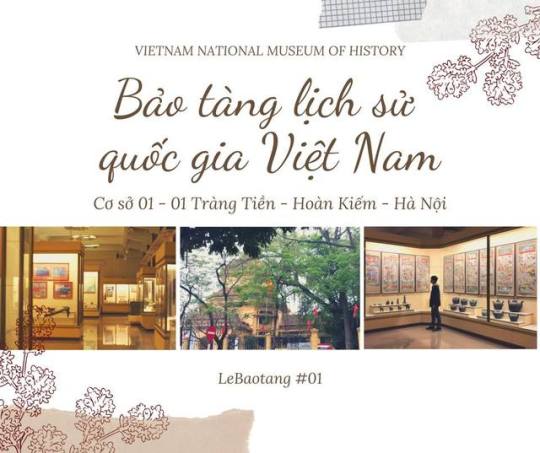
(BẢO TÀNG LỊCH SỬ QUỐC GIA VIỆT NAM – CƠ SỞ 1)
// the National Museum of Vietnamese History • Địa chỉ: 01 Tràng Tiền – Hoàn Kiếm – Hà Nội
• Giá vé:
- 20.000đ/ vé cho sinh viên Đại học, Cao đẳng, Trung cấp
- 10.000đ/ vé cho học sinh
- 40.000đ/ vé cho người lớn và miễn phí vé cho trẻ em
• Gửi xe: 5.000đ/ xe gửi tại cơ sở 2 đối diện tại Trần Quang Khải
• Giờ mở cửa:
- Sáng: Từ 8h00 đến 12h00
- Chiều: Từ 13h30 đến 17h00
• Hệ thống trưng bày mở cửa tất cả các ngày trong tuần, trừ ngày thứ Hai tuần đầu tiên hàng tháng.
(English caption down below)
Là một trong những bảo tàng lâu đời nhất Việt Nam với tuổi đời khoảng 60, bảo tàng LSQGVN dường như trải dài theo thời gian lịch sử của Hà Nội. Nói về kiến trúc, mình tin chắc chắn các bạn sẽ rất thích không gian bên ngoài cũng như bên trong của bảo tàng. Bảo tàng mang một hình ảnh đầy cổ kính với nét kiến trúc kết hợp kiến trúc thuần Việt hòa trong nét Đông – Tây. Một điều trước hết mình muốn lưu ý với các bạn rằng tào tàng này có 2 cơ sở. Thực chất thì trước kia nó là 2 bảo tàng bao gồm Bảo tàng lịch sử Việt Nam và Bảo tàng Cách mạng Việt Nam. Chính vì thế khi đi tham gian bảo tàng này bạn nên nhớ đi bảo tàng ở cơ sở 1 - 01 Tràng Tiền trước, để có thể tham quan theo đúng trình tự thời gian nhé! Và đừng quên giữ lại chiếc vé bởi nó có 2 liên sử dụng cho cả 2 cơ sở.
Ở cơ sở 1 này các bạn sẽ được khám phá đầy đủ nhất về lịch sử Việt Nam từ thời Tiền sử cho tới thời Nguyễn – 1945. Ngay trong cổng vào là phòng bán vé. Các cô nhân viên bán vé rất thân thiện và luôn hỏi chúng mình về thẻ sinh viên. Mình hi vọng là các bạn cũng sẽ không quên nó khi đi vào tàng. Khi bắt đầu vào thăm quan thì chắc chắn cảm xúc của các bạn sẽ là ‘Wow’. Bảo tàng của chúng ta thật lộng lẫy không khác gì một nhà hát Opera cung điện hoàng gia với những chiếc đèn chùm sáng lung linh!
Phía góc trái từ cổng chính là phòng trưng bày chuyên đề. Hiện tại bảo tàng đang thực hiện trưng bày chuyên đề mang tên “Bí mật đại dương từ những con tàu cổ”. Thực sự là rất thú vị khi mà bạn có thể khám phá những di sản gốm từ những chuyến vượt biển của người thủy thủ xa xưa. Mình cũng thật tự hào khi chuyên đề lần này nói về biển cả, một phần vô cùng quan trọng và không thể thiếu đối với văn hóa Việt. Tiếp đến, khi bạn vào bên trong, hãy nhớ rằng bạn nên đi theo chiều từ phải sang trái (tức ngược kim đồng hồ) để đúng với tiến trình của lịch sử. Từ đây, bạn sẽ không thể bỏ lỡ những di sản từ thời đồ đá, kim khí của thời đại mang tên “thời Hùng Vương”. Đặc biệt nhất trong số đó phải kể tới là trống Đồng từ khắp các vùng miền trên cả nước như Ngọc Lữ, Lạng Sơn, Duy Tiên v.v. Ngoài ra, tại đây còn trưng bày vô số các đồ dùng sinh hoạt hay trang sức của người xưa. Và các bạn có tin không? Trong hệ thống trưng bày còn có cả bùa gốm các bạn ạ! Từ những minh chứng trên, ta có thể thấy đời sống và tín ngưỡng của ông cha ta phong phú như thế nào.
Tầng hai mở ra một trang lịch sử đầy đặc sắc của các triều đại phong kiến tự chủ Việt Nam từ Ngô, Đinh, Tiền Lê cho đến Lý, Trần, Lê, Nguyễn. Chắc chắn bạn sẽ có những sự so sánh rất cụ thể về đời sống văn hóa qua mỗi triều đại bởi bảo tàng được xếp các hiện vật theo trình tự của lịch sử. Không biết các bạn cảm nhận như thế nào nhưng mình đặc biệt ấn tượng với trang phục, mũ, ngai vàng của nhà vua thời xưa. Cảm giác lúc ấy như mình đang nhập vai với thời cổ trang vậy! Đi hết quỹ đạo lịch sử phong kiến thì bạn đừng quên trên nơi trưng bày văn hóa Phù Nam – Óc Eo nhé! Đây là một nền văn hóa đặc sắc không kém của người Việt với những trang sức vô cùng nghệ thuật. Mặc dù chỉ chiếm một diện tích khiêm tốn nhưng chính khu vực này lại khiến cho mình thực sự cảm nhận văn hóa Việt Nam không chỉ là văn hóa của người Việt mà nó còn đa dạng hơn thế.
Cảm ơn các bạn đã khám phá cùng mình bảo tàng đầu tiên. Mình hi vọng vác bạn cũng sẽ chọn bảo tàng LSQGVN đầu tiên nếu có ý định khám phá các bảo tàng như mình. Mỗi bảo tàng quả là mỗi “cỗ máy thời gian” giúp bạn hiểu hơn rất nhiều nơi về đất nước Việt Nam, nơi mà mình sinh ra và lớn lên!
—
( the National Museum of Vietnamese History – Part 1)
• Address: No.1 Trang Tien street, Hoan Kiem district, Hanoi city
• Ticket fee:
- 20.000 VND per student from college, university or vocational school
- 10.000 VND per graded student
- 40.000 VND per guest
- Free of charge for young kids, disabled people and Vietnamese soldiers
• Parking fee: 5.000 VND (you may park in the second location of the museum, at no. 216 Tran Quang Khai str.)
• Open time:
- Morning: 8.am – 12 a.m
- Evening: 1.30p.m – 5p.m
• Exhibitions displayed all week except the first Monday of every month
As one of the oldest museums in Vietnam, the National Museum of Vietnamese History has been here for 60 years. I am sure you will like it inside and out falling for its ancient beauty. The museum blooms elegantly with a fancy architecture showing both oriental and eastern influence.
One thing to keep in mind that this museum has two parts. It is actually two museums in one, including the National Museum of Vietnamese History and the Museum of Vietnamese Revolutionary. That is why you should visit one place to another, starting off with the first part on Trang Tien street. Keep the same ticket afterwards for the second part.
During this adventure to the first part, you will be exploring the history of Vietnam from prehistory to 1945, which is around Nguyen dynasty. Going straight forward you shall find the reception to buy your tickets. The receptionists are so friendly when they require us for our student cards. Enter the main hall we go! I bet your first expression of this could be pretty much like ours – like, Wow! It is so fancy it could probably be an Opera house or a royal palace with shinning chandeliers.
From the left of main gate is the latest exhibition and gallery. Here the museum shows us the exhibition called ‘Maritime secrets from the ancient shipwrecks’. It is also a thrill finding out about ancient ceramic show-pieces in the next exhibition. Gotta say I am proud to see everything there, just to understand more about the traditional values. Moving on to the next exhibition. Make sure you follow the direction from right to left. This helps you not miss the display of ancient objects from the Hung Vuong time. The most special thing is definitely the collection of Dong Son from so many places in Vietnam such as Ngoc Lu, Lang Son, Duy Tien, etc. There are also objects explaining the life once lived. Things we see with our own eyes here really recreate the lively world of Vietnamese ancient people.
The second floor actually opens a new world for us about Vietnam feudal era of Ngo, Dinh, Tien Le, Ly, Tran, Le So and Nguyen dynasty. You will sure have specific comparisons among these as the museum sets out different sections for each dynasty. To my surprise, there are even ceramic amulets! Well, I don’t know about you, but I am very impressed by the national treasures here. It sure is the moment of our lives when we feel like we are blended to that ancient world. Oh, and there is a Phu Nam – Oc Eo and Champa exhibitions for you to discover. Here lies a lot of ancient sculptures and masterpieces. Despite the fact that these exhibitions are small, they have what it takes to get me back to the roots of culture.
Thank you so much for coming along with me during my first museum trip ever. If you want to check out cool stuff around here, you need to give the National Museum of Vietnamese History a go. This museum, I gotta say, it is like the machine taking me back to the roots of my Fatherland!
0 notes
Photo
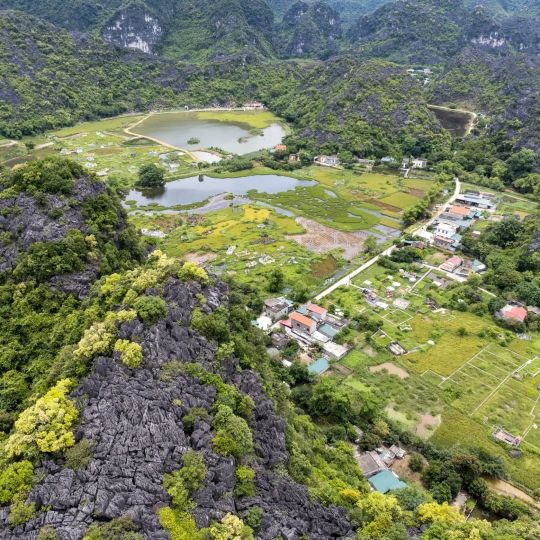
The First Capital Hoa Lu of The Feudal States of Vietnam 🇻🇳💯📸😊 Greetings and have a fantastic day all. ~~~~ Located near the town of Ninh Binh, 90 km south of Hanoi, Hoa Lu Ancient Capital is the capital of an ancient Vietnamese Kingdom called Dai Co Viet in the 10th century. This small Kingdom covered an area of only 300 hectares, and reigned from the 10th century, during the Dinh and Le dynasties, to the 11th century, during the Ly Dynasty. The Kingdom was enclosed by a citadel. The citadel and the Yen Ngua limestone hills provided a good defence for this kingdom against the Chinese. . . . #việtnam #vietnam🇻🇳 #vietnamcharm #vietnamtravels #vietnamnow #vietnamphotography #vietnamwonders #vietnamflashback #vietnamtourism #vietnamstreetphotography #vietnamtravel #vietnamtrip #vietnamstyle #vietnamlife #beautifulseasia #travelsoutheastasia #southeastasiatrip #discoverasia #visitasia #seasia #seasiatravel #southeastasiatravel #total_asia #amazingasia #asia_vacations #asiaphotography #asianwanderlust #asiatour #asiatravel #asiatravels (at Hoa Lu Ancient Capital Vietnam) https://www.instagram.com/p/CgTMjyUP2KH/?igshid=NGJjMDIxMWI=
#việtnam#vietnam🇻🇳#vietnamcharm#vietnamtravels#vietnamnow#vietnamphotography#vietnamwonders#vietnamflashback#vietnamtourism#vietnamstreetphotography#vietnamtravel#vietnamtrip#vietnamstyle#vietnamlife#beautifulseasia#travelsoutheastasia#southeastasiatrip#discoverasia#visitasia#seasia#seasiatravel#southeastasiatravel#total_asia#amazingasia#asia_vacations#asiaphotography#asianwanderlust#asiatour#asiatravel#asiatravels
0 notes